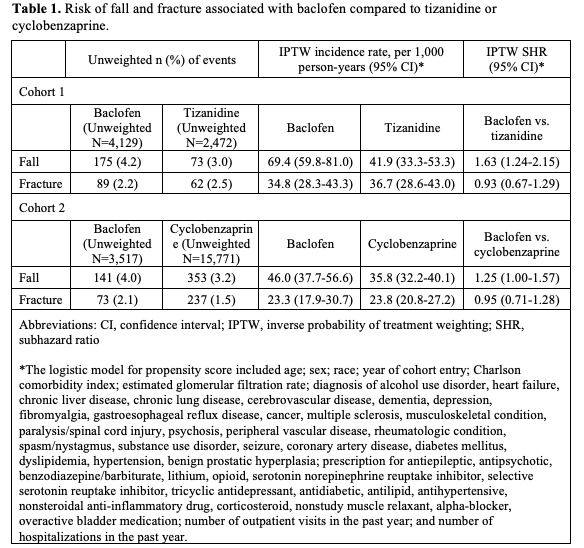Background: The growth of oral muscle relaxant prescriptions among older adults in the U.S. raises safety concern. Baclofen is a commonly used gamma-aminobutyric acid (GABA) agonist muscle relaxant that is associated with encephalopathy. We aimed to compare the risk of fall and fracture associated with oral baclofen against other muscle relaxants (tizanidine or cyclobenzaprine) in older adults.
Methods: We conducted a new-user, active-comparator study of two pairwise cohorts using tertiary health system data from Geisinger Health, Pennsylvania (2005–2018). Cohort 1 comprised of older adults (aged ≥65 years) newly treated with baclofen or tizanidine. Cohort 2 included older adults newly treated with baclofen or cyclobenzaprine. Propensity score-based inverse probability of treatment weighting (IPTW) was used to balance the respective cohorts on 48 patient characteristics, including demographics, comorbidities, and coprescriptions. Fine-Gray competing risk regression was used to estimate the risk of fall and fracture. We additionally assessed the risk of fall in subgroups defined by estimated glomerular filtration rate (eGFR; < 60 or ≥60 ml/min/1.73 m2) and concomitant opioid use (yes or no).
Results: Cohort 1 comprised of 4,129 new baclofen users and 2,472 new tizanidine users. Cohort 2 included 3,517 new baclofen users and 15,771 new cyclobenzaprine users. The median (interquartile interval) duration of follow-up for Cohort 1 was 104 (41-258) days and for Cohort 2 was 113 (44-279) days. Baclofen was associated with a higher risk of fall compared to tizanidine (IPTW incidence rate, 69.4 vs. 41.9 per 1,000 person-years; subdistribution hazard ratio [SHR], 1.63 [95% CI, 1.24-2.15]), but not compared to cyclobenzaprine (SHR, 1.25 [95% CI, 1.00-1.57]). The risk of fall was similar across the subgroups of eGFR and concomitant opioid use (all interaction P >0.05). The risk of fracture was similar among patients treated with baclofen compared to tizanidine (SHR, 0.93 [95% CI, 0.67-1.29]) or cyclobenzaprine (SHR, 0.95 [95% CI, 0.71-1.28]).
Conclusions: The risk of fall associated with baclofen was greater than tizanidine, but similar to cyclobenzaprine in older adults. The risk of fracture was comparable among the older users of baclofen, tizanidine, and cyclobenzaprine. Our findings may inform risk-benefit considerations in the increasingly common clinical encounters where oral muscle relaxants are prescribed.

